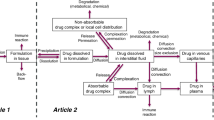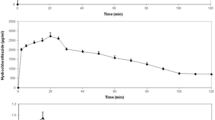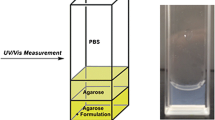Abstract
Absorption of subcutaneously injected soluble insulin deviates markedly from simple first-order kinetics and depends both on the volume and concentration of the injected solution. This paper presents a model of the absorption process in which insulin is presumed to be present in subcutis in a low molecular weight form, a high molecular weight form, and an immobile form where the molecules are bound to the tissue. The model describes how diffusion and absorption gradually reduce the insulin concentrations in the subcutaneous depot and thereby shift the balance between the three forms in accordance with usual laws of chemical kinetics. By presuming that primarily low molecular weight insulin penetrates the capillary walls, the model can account for experimentally observed variations in the absorption rate over a wide range of volumes and of concentrations. The model is used to determine the effective diffusion constant D for insulin in subcutis, the absorption rate constant B for low molecular weight insulin, the equilibrium constant Q between high and low molecular weight insulin, the binding capacity C for insulin in the tissue, and the average life time T for insulin in its bound state. Typical values for a bolus injection in the thigh of fasting type I diabetic patients are D=0.9 × 10−4 cm2/min, B=1.3 × 10−2/min, and Q=0.13 (ml/IU)2. Binding of insulin in the tissue is significant only at small concentrations. The binding capacity is of the order of C=0.05 IU/cm3 with a typical average life time in the bound state of T=800 min. Combined with a simplified model for distribution and degradation of insulin in the body, the absorption model is used to simulate variations in plasma free insulin concentrations with different delivery schedules, i.e., bolus injection and dosage by means of an infusion pump. The simulations show that a pump repetition frequency of 1–2 per hr is sufficient to secure an almost constant plasma insulin concentration.
Similar content being viewed by others
References
M. Berger, H. J. Cüppers, H. Hegner, V. Jörgens, and P. Berchtold. Absorption kinetics and biologic effects of subcutaneously injected insulin preparations.Diabetes Care 5:77–91 (1982).
C. Binder, T. Lauritzen, O. Faber, and S. Pramming. Insulin pharmacokinetics.Diabetes Care 7:188–199 (1984).
C. Binder. Absorption of injected insulin.Acta Pharmacol. Toxicol. 27(Suppl. 2):1–84 (1969).
E. W. Moore, M. L. Mitchell, and T. C. Chalmers. Variability in absorption of insulin-I131 in normal and diabetic subjects after subcutaneous and intramuscular injection.J. Clin. Invest. 38:1222–1227 (1959).
J. A. Galloway, C. T. Spradlin, R. L. Nelson, S. M. Wentworth, J. A. Davidson, and J. L. Swarner. Factors influencing the absorption, serum insulin concentration, and blood glucose responses after injections of regular insulin and various insulin mixtures.Diabetes Care 4:366–376 (1981).
K. Kolendorf, J. Bojsen, and T. Deckert. Clinical factors influencing the absorption of125I-NPH insulin in diabetic patients.Horm. Metab. Res. 15:274–78 (1983).
K. Kolendorf, and J. Bojsen. Storage telemetry for detection subcutaneous absorption of protamine125I-insulin in newly diagnosed, ketotic and non-ketotic insulin dependent diabetes.Acta Endocrinol. (Suppl.)88:51 (1978).
D. A. Henry, J. M. Lowe, D. Citrin, and W. G. Manderson. Defective absorption of injected insulin.Lancet 2:741 (1978).
K. Kolendorf, J. Bojsen, and S. L. Nielsen. Adipose tissue blood flow and insulin disappearance from subcutaneous tissue.Clin. Pharmacol. Ther. 25:598–604 (1979).
V. A. Koivisto, and P. Felig. Effects of leg exercise on insulin absorption in diabetic patients.New Engl. J. Med. 298:79–83 (1978).
V. A. Koivisto. Sauna-induced acceleration in insulin absorption from subcutaneous injection site.Br. Med. J. 280:1411–13 (1980).
S. Pramming, T. Lauritzen, B. Thorsteinsson, K. Johansen, and C. Binder. Absorption of soluble and isophane semi-synthetic human and porcine insulin in insulin-dependent diabetic subjects.Acta Endocrinol. 105:215–220 (1984).
K. Kolendorf, J. Bojsen, and T. Deckert. Absorption and miscibility of regular porcine insuline after subcutaneous injection of insulin-treated diabetic patients.Diabetes Care 6:6–9 (1983).
A. Murat and G. Slama. Influence of concentration on the kinetics of sc-infused insulin. Comparison between square-wave sc infusion and bolus sc injection.metabolism 34:120–123 (1985).
J. Schou. Absorption of drugs from subcutaneous connective tissue.Pharmacol. Rev. 13:441–464 (1964).
G. Williams, J. Pickup, A. Clark, S. Bowcock, E. Cooke, and H. Keen. Changes in blood flow close to sucutaneous insulin injection sites in stable and brittle diabetics.Diabetes 32:466–473 (1983).
C. Binder. A theoretical model for the absorption of soluble insulin. In P. Brunettiet al. (eds.),Artificial Systems for Insulin Delivery, Raven Press, New York, 1983, pp. 53–57.
P. Hildebrandt, P. Sejrsen, S. L. Nielsen, K. Birch, and L. Sestoft. Diffusion and polymerization determines the insulin absorption from subcutaneous tissue in diabetic patients.Scand. J. Clin. lab. Invest. 45:685–690 (1985).
E. A. Rasio. The displacement of insulin from blood capillarites.Diabetologia 5:416–419 (1969).
K. Okumura, F. Komada, and R. Hori. Fate of porcine and human insulin at the subcutaneous injection site. I. Degradation and absorption of insulin in the rat.J. Pharmacobiodyn. 8:25–32 (1985).
U. Fischer, E.-J. Freyse, E. Jutzi, W. Besch, M. Raschke, S. Höfer, and G. Albrecht. Absorption rates of subcutaneously injected insulin the dog as calculated from the plasma insulin levels of means of a simple mathematical model.Diabetologia 24:196–201 (1983).
T. Kobayashi, S. Sawano, T. Itoh, K. Kosaka, H. Hirayama, and Y. Kasya. The pharmacokinetics of insulin after continuous subcutaneous infusion or bolus subcutaneous injection in diabetic patients.Diabetes 32:331–336 (1983).
E. W. Kraegen and D. J. Chisholm. Insulin responses to varying profiles of subcutaneous insulin infusion: Kinetic modelling studies.Diabetologia 26:208–213 (1984).
T. Deckert, B. Hansen, K. Kolendorf, J. S. D. Poulsen, and M. Smith. Absorption of NPH-insulin from subcutaneous tissue: A methodological study in pigs.Acta Pharmacol. Toxicol. 51:30–37 (1982).
J. M. Creeth. Maximum molecular weight of insulin.Nature 170:210 (1952).
R. P. Eaton, R. C. Allen, and D. S. Schade. Hepatic removal of insulin in normal man: Dose response to endogeneous insulin secretion.J. Clin. Endocrinol. Metab. 56:1294–1300 (1983).
R. Rabkin, M. P. Ryan, and W. C. Duckworth. The renal metabolism of insulin.Diabetologia 27:351–357 (1984).
M.J. Chamberlain and L. Stimmler. The renal handling of insulin.J. Clin. Invest. 46:911–919 (1967).
T. Lauritzen, S. Pramming, T. Deckert, and C. Binder. Pharmacokinetics of continuous subcutaneous insulin infusion.Diabetologia 24:326–329 (1983).
J. C. Pickup, H. Keen, J. A. Parsons, and K. G. M. M. Alberti. Continuous subcutaneous insulin infusion: An approach to achieving normoglycemia.Br. Med. J. 1:204–207 (1978).
K. Kolendorf, J. Bojsen, and B. Lorup. Improvement of glucose homeostasis in insulindependent diabetics using a miniature insulin infusion pump with a fixed profile.Diabetologia 18:141–145 (1980).
P. Hildenbrandt, K. Birch, B. Moller Jensen, C. Kühl, and J. Brange. Absorption of subcutaneously infused insulin: Influence of the basal rate pulse interval.Diabetes Care 8:287–289 (1985).
C. Levy-Marchal, A. M. Albisser, and B. Zinman. Overnight metabolic control with pulsed intermittent versus continuous subcutaneous insulin infusion.Diabetes Care 6:356–360 (1983).
K. F. Hanssen, K. Dahl-Jorgensen, T. Lauritzen, B. Feldt-Rasmussen, O. Brinchmann-Hansen, and T. Deckert. Diabetic control and microvascular complications: The near-normoglycaemic experience.Diabetologia 29:677–684 (1986).
K. Jörgensen and C. Binder.125I-insulin as a tracer of insulin in different chemical processes. In L. Donato, G. Milhaud, and J. Sirchis (eds.)Labelled Proteins in Tracer Studies, EURATOM, Brussels, 1960, pp. 329–333.
Author information
Authors and Affiliations
Rights and permissions
About this article
Cite this article
Mosekilde, E., Jensen, K.S., Binder, C. et al. Modeling absorption kinetics of subcutaneous injected soluble insulin. Journal of Pharmacokinetics and Biopharmaceutics 17, 67–87 (1989). https://doi.org/10.1007/BF01059088
Received:
Revised:
Published:
Issue Date:
DOI: https://doi.org/10.1007/BF01059088




